82 results
Higher education astronomy study guides

The Martian - Movie Guide - 5 Resources including Word Search & Crossword Puzzle
Embark on an out-of-this-world cinematic experience with my exclusive bundle tailored for classrooms watching the 2015 film "The Martian." This comprehensive bundle has everything you need to enhance your class's viewing experience. Start with a curated list of thought-provoking questions to ponder during the film, stimulating discussion and deepening your appreciation for the storyline and characters. After the credits roll, continue the excitement with another set of engaging questions to spar
Subjects:
Grades:
9th - 12th, Higher Education, Adult Education

Concept Compare: Kepler's (and Newton's) Laws of Planetary Motion for Orbits
This concept comparison is between: Kepler's Laws of Planetary Motion, and how they relate to Newton's Laws of Motion and the Law of Universal Gravitation. Bring a calculator!The Concept Comparison Routine is used help compare and contrast key concepts. Specifically, students use like and unlike characteristics and categories shared and not shared by two or more concepts to better understand the overall concept. Students taught using the Content Enhancement routines earned higher total test scor
Subjects:
Grades:
7th - 12th, Higher Education
NGSS:
HS-ESS1-4
Also included in: StayGiant Earth Science Bundle: Astronomy (space exploration)

Study Guides for “Astronomy: A Self-Teaching Guide” (Moche): Ch. 01-07
I use Dinah Moche's popular work "Astronomy: A Self-Teaching Guide" as a textbook for my elective high school Astronomy class. While teaching Astronomy, I prepared PowerPoint slides to accompany each chapter that I use from the book. I offered these teaching slides for free as a service to the TpT community. I also created study guide handouts for chapters 01-07 of Moche’s book. The study guides can serve as “guided notes” for the PowerPoint slides. They include questions, diagrams, and vocabula
Subjects:
Grades:
10th - 12th, Higher Education
Types:

Concept Compare: Why Does the Sun Shine? Thermonuclear Fusion! (p-p and CNO)
This Concept Comparison of Thermonuclear Fusion contrasts proton-proton (p-p) chain reactions, and the "cold" carbon-nitrogen-oxygen (CNO) cycles. Help Ss communicate scientific ideas about the way stars produce elements over their life cycle. Emphasis is on the way nucleosynthesis, and therefore the different elements created, varies as a function of the mass of a star and the stage of its lifetime. As cosmologist Carl Sagan famously said, “We are made of star stuff.” And we literally are! We a
Subjects:
Grades:
8th - 12th, Higher Education
NGSS:
HS-PS1-8
, HS-ESS1-3
, HS-ESS1-1
Also included in: StayGiant Earth Science Bundle: Astronomy (space exploration)

Heliocentric Vs. Geocentric Card Sort
This interactive and hands-on card sort will allow your students to differentiate between the heliocentric and geocentric model. This card sort has 12 different cards of images and descriptions that apply to the geocentric and heliocentric model as well as the astronomers that supported each model.The card sort mainly focuses on ptolemy, Copernicus and Galileo. This card sort is perfect for interactive notebooks, guided practice, or informal assessments.
Subjects:
Grades:
8th - 12th, Higher Education, Adult Education
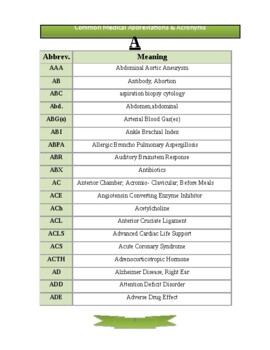
Medical Terminology Abbreviations A-Z
Ready to print and use flashcards for abbreviations in Medical Terminology sorted by Body Systems! There are pages that contain the common abbreviations used in the Medical Terminology language. The body systems included are Body Organization, Integumentary System, Muscular System, Skeletal System, Cardiovascular System, Blood, Lymphatic and Immune Systems, Respiratory System, Digestive System, Urinary System, Reproductive System, Endocrine System, and Nervous System. Hopefully you will find
Subjects:
Grades:
6th - 12th, Higher Education, Adult Education, Staff
![Preview of [TED ED] [Out of this World] #31-48 Astronomy 16 worksheets Bundle (3)](https://ecdn.teacherspayteachers.com/thumbitem/-TED-ED-Out-of-this-World-31-48-Astronomy-16-worksheets-Bundle-3--8084940-1652697239/original-8084940-1.jpg)
[TED ED] [Out of this World] #31-48 Astronomy 16 worksheets Bundle (3)
[TED ED] [Out of this World] #31-48 Astronomy 16 worksheets Bundle31 What light can teach us about the universe 32 How to detect a supernova 33 Could comets be the source of life on Earth?35 Can a black hole be destroyed? 36 There may be extraterrestrial life in our solar system 37 The dust bunnies that built our planet 38 Einstein's twin paradox explained 39 Are we living in a simulation? 41 NASA’s first software engineer: Margaret Hamilton42 Newton’s three-body problem explained43 Could we har
Subjects:
Grades:
8th - 12th, Higher Education, Adult Education
Types:
![Preview of [TED ED] [Out of this World] #1-15 Astronomy 15 worksheets Bundle](https://ecdn.teacherspayteachers.com/thumbitem/-TED-ED-Out-of-this-World-1-15-Astronomy-15-worksheets-Bundle-8084454-1652684049/original-8084454-1.jpg)
[TED ED] [Out of this World] #1-15 Astronomy 15 worksheets Bundle
[TED ED] [Out of this World] #1~15 Astronomy 15 worksheets Bundle1 Could we actually live on Mars? 2 Where does gold come from? 3 The journey to Pluto, the farthest world ever explored 4 Light seconds, light years, light centuries: How to measure extreme distances 5 How fast are you moving right now?6 The death of the universe7 Who won the space race? 8 The beginning of the universe, for beginners 9 How small are we in the scale of the universe? 10 The moon illusion 11 What creates a total solar
Subjects:
Grades:
8th - 12th, Higher Education, Adult Education
Types:
![Preview of [TED ED] [Out of this World] #16-30 Astronomy 15 worksheets Bundle](https://ecdn.teacherspayteachers.com/thumbitem/-TED-ED-Out-of-this-World-16-30-Astronomy-15-worksheets-Bundle-8084742-1652693845/original-8084742-1.jpg)
[TED ED] [Out of this World] #16-30 Astronomy 15 worksheets Bundle
[TED ED] [Out of this World] #16~30 Astronomy 15 worksheets Bundle16 Is there a center of the universe? 17 Why is NASA sending a spacecraft to a metal world? 18 Should we be looking for life elsewhere in the universe?19 Three ways the universe could end 20 What is the universe made of? 21 Sunlight is way older than you think 22 Four ways to understand the Earth's age 23 How far would you have to go to escape gravity?24 Could we survive prolonged space travel? 25 Would you live on the moon?26 How
Subjects:
Grades:
8th - 12th, Higher Education, Adult Education
Types:

Question Exploration: How Did the Moon Form? GIANT IMPACT!
What are the violent origins of the Moon? The most widely accepted scenario for the formation of the Earth–Moon system involves a dramatic collision between the early Earth and some other cosmic body, with the present-day Moon thought to have coalesced from the debris ejected by a giant impact. This Question Exploration helps Ss explore the Giant Impact Theory of lunar formation.The first FRAME is a concept comparison among our Moon Luna, Mars' moons Phobos and Deimos, and the six largest natura
Subjects:
Grades:
8th - 12th, Higher Education
NGSS:
MS-ESS1-4
, HS-ESS1-6
, HS-ESS1-4
, HS-ESS1-5
Also included in: StayGiant Earth Science Bundle: Astronomy (space exploration)
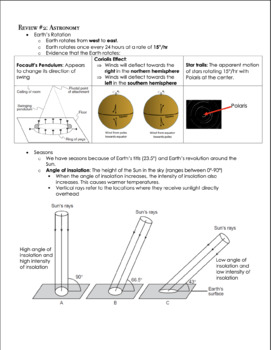
Earth Science Regents Review 2
This is a regents review packet that goes over the entire unit of Astronomy. The topics that are went over:Earth' RotationSeasons and Angle of InsolationCelestial SpheresMoon Phases, Ocean Tides, EclipsesOrbits (Eccentricity- ESRT pg. 1)Solar System Data (ESRT pg. 15)Celestial Objects (i.e. Asteroids, Comets, Meteoroids, Meteor, and Meteorite)Theories of our solar system (Geocentric vs. Heliocentric)Stars and Galaxies (ESRT pg. 15- "Characteristics of Stars")Origin of the Universe and the Organi
Subjects:
Grades:
8th - 12th, Higher Education
Types:
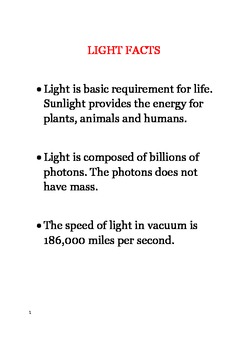
Light Facts - Light wave, sun light, speed of light, bulbs, photons
There are 95 facts about light. These are interesting facts about light wave, sun light, speed of light, bulbs, photons, lightning, tungsten, reflection, refraction, ultraviolet, infrared and more..
Light Facts by Jega Chinna is licensed under a Creative Commons Attribution-NonCommercial-NoDerivs 3.0 Unported License.
Subjects:
Grades:
3rd - 12th, Higher Education, Adult Education, Staff
Types:
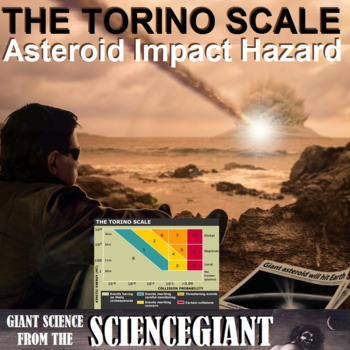
Concept Compare: Small Solar System Bodies (Comets, Asteroid, and Meteors)
A shooting star is not a star - it's not a "star" at all.A shooting star's a meteor, heading for a fall!This Concept Comparisons consists of three Frame Routines to help Ss contrast comets, asteroids, meteoroids, meteors, and meteorites. The final Frame contrasts types of meteorites: stony, iron, and stony-iron. The middle asks the Essential Question: How serious does an asteroid threat have to be before action is taken? To help communicate the hazard, the Torino Impact Hazard Scale assigns an i
Subjects:
Grades:
8th - 12th, Higher Education
Also included in: StayGiant Earth Science Bundle: Astronomy (space exploration)
![Preview of [TED ED] [Out of this World] #9 How small are we in the scale of the universe?](https://ecdn.teacherspayteachers.com/thumbitem/-TED-ED-Out-of-this-World-9-How-small-are-we-in-the-scale-of-the-universe--8084422-1652682080/original-8084422-1.jpg)
[TED ED] [Out of this World] #9 How small are we in the scale of the universe?
1 Could we actually live on Mars? 2 Where does gold come from? 3 The journey to Pluto, the farthest world ever explored 4 Light seconds, light years, light centuries: How to measure extreme distances 5 How fast are you moving right now?6 The death of the universe7 Who won the space race? 8 The beginning of the universe, for beginners 9 How small are we in the scale of the universe? 10 The moon illusion 11 What creates a total solar eclipse? 12 What is the universe expanding into?13 Could the Ear
Subjects:
Grades:
8th - 12th, Higher Education, Adult Education
Types:
Also included in: [TED ED] [Out of this World] #1-15 Astronomy 15 worksheets Bundle
![Preview of [TED ED] [Out of this World] #36 There may be extraterrestrial life in our solar](https://ecdn.teacherspayteachers.com/thumbitem/-TED-ED-Out-of-this-World-36-There-may-be-extraterrestrial-life-in-our-solar-8084828-1652695491/original-8084828-1.jpg)
[TED ED] [Out of this World] #36 There may be extraterrestrial life in our solar
31 What light can teach us about the universe 32 How to detect a supernova 33 Could comets be the source of life on Earth?35 Can a black hole be destroyed? 36 There may be extraterrestrial life in our solar system 37 The dust bunnies that built our planet 38 Einstein's twin paradox explained 39 Are we living in a simulation? 41 NASA’s first software engineer: Margaret Hamilton42 Newton’s three-body problem explained43 Could we harness the power of a black hole? 44 What if every satellite suddenl
Subjects:
Grades:
8th - 12th, Higher Education, Adult Education
Types:
Also included in: [TED ED] [Out of this World] #31-48 Astronomy 16 worksheets Bundle (3)
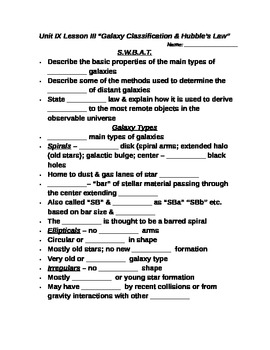
Student Note Guide PPT Unit IX Lesson III "Galaxy Classification Hubble's Law"
Student guide/worksheet to the PowerPoint Lesson III Unit IX "Galaxy Classification and Hubble's Law." Included is an answer key.
All files including PowerPoint lessons; ActivInspire reviews; worksheets/activities and assessments can be found under "Complete Astronomy Unit IX Milky Way and Other Galaxies" zip file.
Terms in this lesson include:
Galaxy types
Spiral galaxies
Elliptical galaxies
Irregular galaxies
Colliding galaxies
Milky Way
Andromeda
Large Magellanic Cloud
Small Magellanic Clou
Subjects:
Grades:
8th - 12th, Higher Education
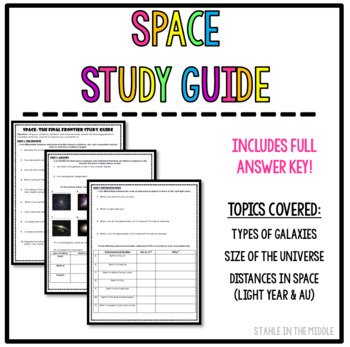
Space Study Guide
33 question unit study guide covering hierarchy of the universe, types of galaxies, and distances in space. This can be used as an independent study guide or review game!Types of questions include short answer and matching. Purchase includes: 1. Three page study guide2. Complete answer key
Subjects:
Grades:
6th - 12th, Higher Education, Adult Education
![Preview of [TED ED] [Out of this World] #2 Where does gold come from? worksheets](https://ecdn.teacherspayteachers.com/thumbitem/-TED-ED-Out-of-this-World-2-Where-does-gold-come-from-worksheets-8084397-1652680918/original-8084397-1.jpg)
[TED ED] [Out of this World] #2 Where does gold come from? worksheets
1 Could we actually live on Mars? 2 Where does gold come from? 3 The journey to Pluto, the farthest world ever explored 4 Light seconds, light years, light centuries: How to measure extreme distances 5 How fast are you moving right now?6 The death of the universe7 Who won the space race? 8 The beginning of the universe, for beginners 9 How small are we in the scale of the universe? 10 The moon illusion 11 What creates a total solar eclipse? 12 What is the universe expanding into?13 Could the Ear
Subjects:
Grades:
8th - 12th, Higher Education, Adult Education
Types:
Also included in: [TED ED] [Out of this World] #1-15 Astronomy 15 worksheets Bundle
![Preview of [TED ED] [Out of this World] #31 What light can teach us about the universe](https://ecdn.teacherspayteachers.com/thumbitem/-TED-ED-Out-of-this-World-31-What-light-can-teach-us-about-the-universe-8084799-1652694750/original-8084799-1.jpg)
[TED ED] [Out of this World] #31 What light can teach us about the universe
31 What light can teach us about the universe 32 How to detect a supernova 33 Could comets be the source of life on Earth?35 Can a black hole be destroyed? 36 There may be extraterrestrial life in our solar system 37 The dust bunnies that built our planet 38 Einstein's twin paradox explained 39 Are we living in a simulation? 41 NASA’s first software engineer: Margaret Hamilton42 Newton’s three-body problem explained43 Could we harness the power of a black hole? 44 What if every satellite suddenl
Subjects:
Grades:
8th - 12th, Higher Education, Adult Education
Types:
Also included in: [TED ED] [Out of this World] #31-48 Astronomy 16 worksheets Bundle (3)
![Preview of [TED ED] [Out of this World] #24 Could we survive prolonged space travel? works](https://ecdn.teacherspayteachers.com/thumbitem/-TED-ED-Out-of-this-World-24-Could-we-survive-prolonged-space-travel-works-8084540-1652688370/original-8084540-1.jpg)
[TED ED] [Out of this World] #24 Could we survive prolonged space travel? works
16 Is there a center of the universe? 17 Why is NASA sending a spacecraft to a metal world? 18 Should we be looking for life elsewhere in the universe?19 Three ways the universe could end 20 What is the universe made of? 21 Sunlight is way older than you think 22 Four ways to understand the Earth's age 23 How far would you have to go to escape gravity?24 Could we survive prolonged space travel? 25 Would you live on the moon?26 How to build a dark matter detector 27 Why neutrinos matter 28 How do
Subjects:
Grades:
8th - 12th, Higher Education, Adult Education
Types:
Also included in: [TED ED] [Out of this World] #16-30 Astronomy 15 worksheets Bundle
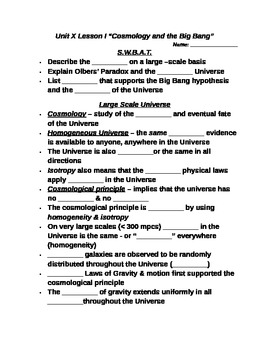
Student Note Guide PPT Unit X Lesson I "Cosmology and the Big Bang"
Student guide/worksheet to the Power point Lesson I Unit X "Cosmology and the Big Bang." Included is an answer key.
All files including Power point lessons; ActivInspire programs; worksheets/activities and assessments can be found under "Complete Astronomy Unit X Cosmology and Life in the Universe" zip file.
Terms in this lesson include:
Cosmology
Big Bang
Homogeneous Universe
Homogeneity
Isotropic Universe
Isotropy
Cosmological Principle
"Great Attractor"
Large Scale Universe
Newton's Laws
Ob
Subjects:
Grades:
8th - 12th, Higher Education
Types:
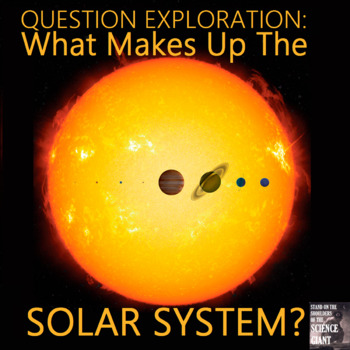
Question Exploration: What Makes Up the Solar System?
This Question Exploration helps students answer What Makes Up the Solar System? What Makes Solar Systems? How Do Solar Systems Form?Question Exploration Routine is an instructional methods that teachers can use to help a diverse student population understand a body of content information by carefully answering a critical question to arrive at a main idea answer. Students taught using the question exploration routine earned higher total test scores than did students taught using the lecture-discu
Subjects:
Grades:
6th - 10th, Higher Education
Also included in: StayGiant Earth Science Bundle: Astronomy (space exploration)
![Preview of [TED ED] [Out of this World] #47 actually building an elevator to space](https://ecdn.teacherspayteachers.com/thumbitem/-TED-ED-Out-of-this-World-47-actually-building-an-elevator-to-space-8084920-1652696827/original-8084920-1.jpg)
[TED ED] [Out of this World] #47 actually building an elevator to space
31 What light can teach us about the universe 32 How to detect a supernova 33 Could comets be the source of life on Earth?35 Can a black hole be destroyed? 36 There may be extraterrestrial life in our solar system 37 The dust bunnies that built our planet 38 Einstein's twin paradox explained 39 Are we living in a simulation? 41 NASA’s first software engineer: Margaret Hamilton42 Newton’s three-body problem explained43 Could we harness the power of a black hole? 44 What if every satellite suddenl
Subjects:
Grades:
8th - 12th, Higher Education, Adult Education
Types:
Also included in: [TED ED] [Out of this World] #31-48 Astronomy 16 worksheets Bundle (3)

Question Explore: How Celestial Coordinates Locate Deep Sky Objects (RA and Dec)
How is the location of an astronomical object specified with celestial coordinates?This Question Exploration helps Ss explain points of reference on the celestial sphere when using the equatorial coordinate system. Determining the right ascension and declination indicates where to look in the sky to see an object, from the moon to Messier objects. It also introduces a "handy" way for star watchers to measure degrees.Question Exploration Routine is an instructional methods that teachers can use t
Subjects:
Grades:
9th - 12th, Higher Education
NGSS:
HS-ESS1-4
Also included in: StayGiant Earth Science Bundle: Astronomy (space exploration)
Showing 1-24 of 82 results





